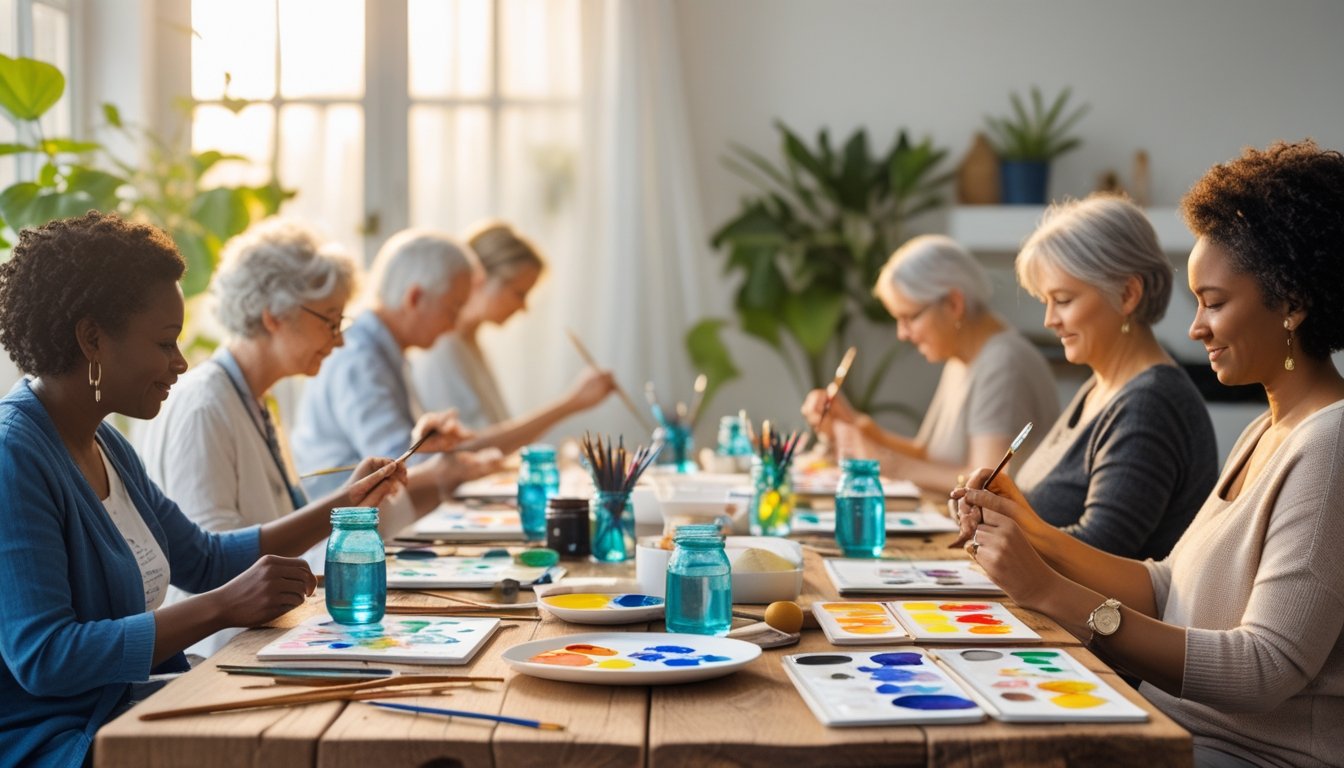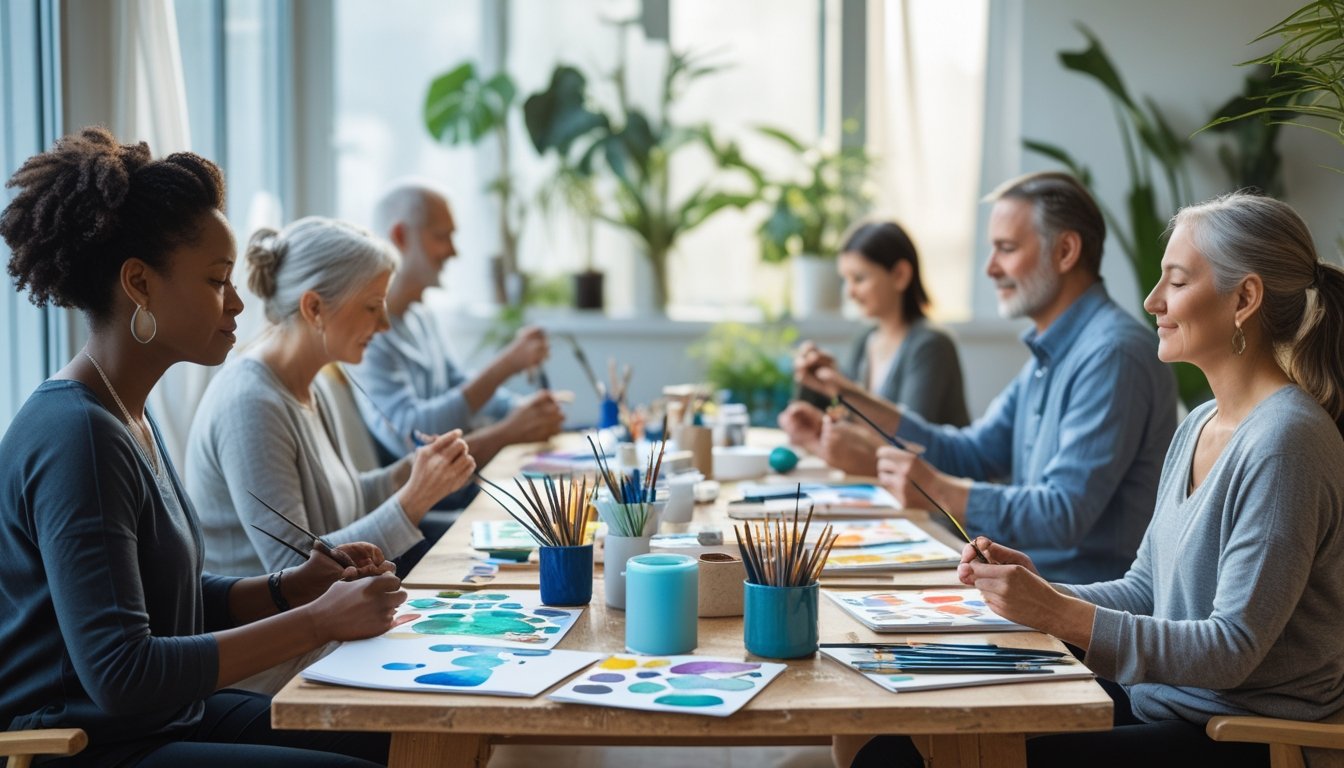Late updated: 28 Nov 2025 13:11
Written by: Ella Thompson
Exploring Mindful Art for Emotional Wellbeing: A Path to Inner Peace
Exploring the intersection of mindfulness and art, we find a powerful means to support our mental health and emotional well-being. Integrating creativity with mindfulness enables us to express our emotions safely and non-verbally. This mindful artistic practice allows us to explore our thoughts and feelings while promoting healing, self-discovery, and emotional release.

Art serves as a unique bridge to emotional wellness that we can all utilise. By engaging in artistic expression, we unlock deeper self-awareness and cultivate present-moment awareness. This practice does not only reduce stress but significantly enhances our overall sense of peace and mental clarity.
Emphasising personalised creativity, mindful art practices offer a variety of ways to engage with our inner thoughts and experiences. From drawing and painting to sculpting, these activities encourage us to reconnect with ourselves and improve our psychological health in daily life. Understanding these implications empowers us to harness art as a tool for transformation.
Key Takeaways
- Mindful art enhances emotional expression and healing.
- Engaging in creative practices deepens self-awareness.
- Art provides stress relief and supports mental clarity.
Mindful Art as a Pathway to Emotional Wellbeing
Mindful art offers a bridge to enhance emotional well-being by integrating the calming effects of mindfulness with the expressive power of art. This approach can foster greater self-awareness, emotional regulation, and psychological resilience.
The Fundamentals of Mindful Art
Mindful art combines two powerful practices — mindfulness and artistic expression — to create an avenue for emotional and psychological wellbeing. It revolves around the practice of bringing one's full attention to the art-making process. By focusing on colours, shapes, and textures, we immerse ourselves fully in the experience, allowing emotions to flow naturally without judgement. This non-judgemental observation is at the heart of both mindfulness and art therapy.
When we engage in mindful art, the emphasis is not on producing a perfect piece of art but on the process itself. This approach acknowledges that the creative journey is more valuable than the outcome. We cultivate a space where emotions can be recognised and expressed safely. Through this, art acts as a translator for feelings that are hard to articulate in words, offering us a sense of relief and understanding.
Mindfulness and the Present Moment in Creativity
Bringing mindfulness into the creative process encourages us to fully engage with the present moment. As we focus on each brushstroke or pencil mark, we draw our attention away from past regrets or future anxieties. This engagement with the present is a cornerstone of mental health practice.
In return, this state of concentrated awareness fosters a richer emotional connection with our work. We find that becoming fully present can unlock deeper layers of creativity and enhance emotional richness. Our creative activities thus evolve into meditative exercises, grounding us and fostering a peaceful mind.
Mindfulness in art also enforces a slowing down of our often hectic lives. This deceleration allows our minds to savour the intricate details of the creative process, promoting relaxation and a respite from stress.
Emotional Regulation Through Artistic Expression
Engaging in mindful art provides a beneficial outlet for emotional regulation. As we create, feelings that might otherwise remain suppressed come to the surface, allowing us to process them in a constructive environment. Artistic expression thus becomes a vital tool for managing emotions effectively.
Art therapy practices incorporate mindfulness to help navigate and regulate complex emotions. By focusing our attention and energy on creative tasks, we can redirect anxious or overwhelming thoughts into something tangible and manageable. It allows us to externalise emotions, reducing their power over us and promoting emotional balance.
Through this, mindful art becomes a therapeutic exercise, enhancing our psychological resilience and nurturing our emotional well-being. This practice supports ongoing mental health and can be integrated into daily life as a consistent and rewarding way to maintain emotional equilibrium.
Practical Approaches and Benefits of Mindful Artistic Practices

Mindful artistic practices offer multiple pathways for emotional well-being. By integrating creativity and mindfulness, we can foster healing through self-expression and enhance emotional resilience.
Exploring Diverse Art Forms for Emotional Healing
Incorporating diverse art forms into our mindful practice can create unique opportunities for self-discovery and emotional healing. Painting, drawing, sculpture, writing, music, and dance each provide distinctive approaches to explore our emotions. Through artistic expression, we are encouraged to engage in self-reflection and develop a deeper understanding of our feelings. This process can lead to personal growth and a greater sense of self-awareness. By participating in activities like art journaling and creative writing, we can further explore our inner self, allowing for emotional release and transformation. Such practices can help manage anxiety, stress, and depression, nurturing compassion and empathy within ourselves and towards others.
Art Therapy Techniques and Activities
Art therapy opens the door to healing and emotional regulation. We can practice mindfulness through structured activities designed to encourage emotional release and to improve self-esteem. Guided by an art therapist, individuals engage in the creative process through painting, drawing, or crafting sculptures. Schools and therapy centres often integrate these activities into their programmes, offering art classes and workshops to support emotional healing. Research shows that creating artworks boosts communication and expression, facilitating personal transformation. Techniques such as mindfulness meditation can be combined with artistic activities to deepen inner awareness, promoting self-compassion and emotional resilience. Our creative journey becomes a therapeutic experience, contributing to improved mental well-being.
Building Resilience and Coping Mechanisms Through Art
Artistic activities not only aid in emotional healing but also strengthen our resilience and coping mechanisms. When we engage in artistic practices, we foster personal growth, nurturing the skills needed to manage life's challenges. Through repeated practice, we develop a resilient mindset, capable of facing stress effectively. Art serves as a means to process complex emotions, providing outlets for emotional expression that traditional communication might not address. This can be particularly beneficial for trauma recovery, where communicating feelings verbally can be difficult. By actively participating in creative expression, we learn to build robust coping strategies, enhancing our capacity to face adversity with a calm and focused approach.
Frequently Asked Questions

Mindful art offers a unique blend of creativity and self-awareness that promotes emotional well-being. By exploring the following questions, we can better understand the benefits and techniques of mindful art therapy.
How can engaging in mindful art activities improve mental health?
Engaging in mindful art activities allows us to express emotions that we might find difficult to articulate verbally. This process can increase self-awareness and promote healing by providing a therapeutic outlet for stress and negative emotions.
What techniques are effective in combining mindfulness with creative expression?
Combining mindfulness with creative expression often involves focusing on the present moment during art-making. Techniques such as deep breathing, setting intentions before starting a project, and using sensory experiences to ground ourselves can enhance the mindfulness aspect of art activities.
Can mindful art therapy contribute to reducing stress and anxiety levels?
Yes, mindful art therapy has been shown to help reduce stress and anxiety by fostering relaxation and detachment from ruminative thoughts. Creating art mindfully can allow us to enter a state of flow, which is calming and restorative.
What are some accessible mindful art exercises for beginners?
For beginners, simple exercises like drawing mandalas, creating spontaneous doodles, or painting with watercolours can be effective. The key is to focus on the process rather than the end product, allowing creativity to unfold naturally.
How does the practice of mindfulness enhance the creative process?
Mindfulness enhances the creative process by encouraging a non-judgmental attitude towards our creations. By being present and attentive, we can explore new ideas without fear of making mistakes, leading to richer and more varied expressions of creativity.
What role does self-compassion play in mindful art for emotional wellbeing?
Self-compassion is fundamental as it allows us to approach our art-making with kindness and acceptance. This attitude reduces self-critical thoughts and enables us to embrace imperfections, fostering a more positive relationship with our inner experiences.
